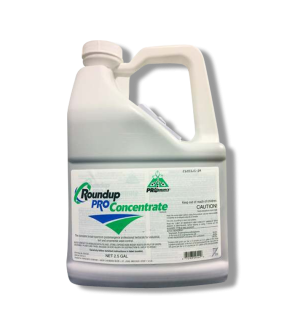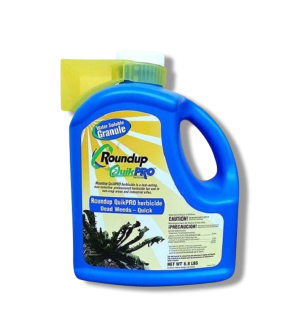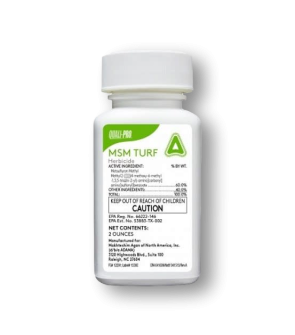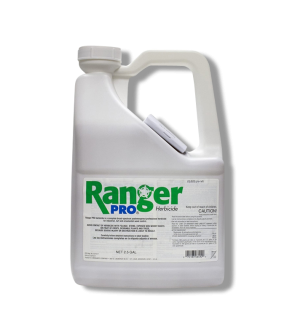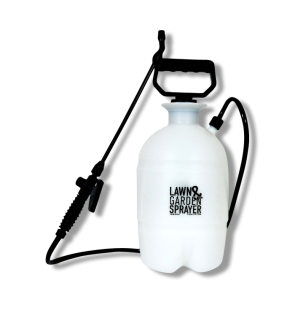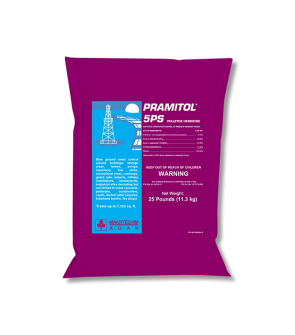Gain access to personalized product screening, the best pricing, rewards, and more!
Most Effective Products
Grassy Weed Control: How to Get Rid of Grassy Weeds
This page is a general grassy weed control guide. Using the products and methods suggested, you can get control of any grassy weed species. The grassy weed category pages give additional information on the different species and specific treatment instructions and options. Follow these guides and use the recommended products, and we guarantee 100% control over all grassy weed types.
Grassy weeds are annoying plants that sneak into your yard despite your diligent efforts to keep them away. They can sometimes be difficult to spot on a lawn because they look like grass but have slight differences from the grass you wish to grow. This makes your turf not as neat and uniform as it should be.
Some of the more sneaky and hard-to-control grassy weeds you often see on lawns are crabgrass, goosegrass, barnyardgrass, and oxalis. If grassy weeds are a regular problem every growing season, this may be an indicator of your lawn suffering from some type of environmental stress, the presence of lawn pests, or improper lawn care practices.
While grassy weeds are not a major threat to your lawn, if left untreated, they can reduce turf quality and the overall appearance of your lawn. Grassy weeds are bullies where established, taking nutrients, sun, and water from your desired grass. If you want a well-kept, uniform lawn that is the envy of the neighborhood, you must address the grassy weeds that are invading.
By combining our professional herbicides and DIY how-to instructions authorized by our experienced lawn care staff, you will learn to effectively get rid of grassy weeds on your lawn safely and affordably.
Identification

Before you can proceed with a treatment program, you need to identify whether the weed you are dealing with is grassy or broadleaf. Misidentification can lead to using the wrong herbicides, which can cost you time and money.
- Grassy weeds differ from broadleaf weeds in that they look like grass. The blades will be slender and long. What makes it a weed is that it happens to be a grass that is different from your main turfgrass.
Once you have Identified the weed growing on your lawn, you can do your homework and learn about how they function and what conditions they thrive in. This will help you deprive them of what they love, sending a message that they aren’t welcome in your yard.
While we have plenty of herbicides that target grassy weeds, the tricky thing with weed control is that a herbicide that might work for one type of weed may not be effective against a different type of grassy weed. Some turfgrass varieties can tolerate selective treatments of post-emergent herbicides, and others will not. In these situations, pre-emergent treatments will provide a safe and effective alternative.
Grassy weed varieties can be some of the more challenging to identify. It’s best to take several close-up and distant pictures to help determine the variety that you are trying to identify. If close-up pictures are taken, it's best to include something like a coin or garden spade in the picture to see the scale of the weed being identified.

Do you know what type of grassy weed you have? A large variety of grassy weeds can grow on a lawn. You can learn more about the most common grassy weeds and see in-depth guides on eliminating each weed from your lawn.
Inspection
Where to Inspect
A thorough inspection of your lawn may provide you with some answers as to why the grass is growing in the first place. Taking note of the time of the year the weed is prevalent and whether your soil has enough nutrients or is under stress can also be factors as to why the target weed is dominating your lawn. A detailed inspection can also help you know where to focus your herbicide treatments.
Grassy weeds are tough, aggressive plants that thrive on areas of your lawn that have not been properly maintained or are under stress. Examples of stress include dried-out lawns, thin patches, areas scorched by the sun, or, on the flip side, where an area that has too much shade is a primary spot for grassy weeds.
What to Look For
You're going to want to observe closely any areas of your yard where there is grass that differs from your turfgrass. Grassy weeds usually grow much quicker than your desired grass, and thus, it will be easy to see it stand out. Here are some additional things we recommend doing during the inspection phase:
- Do a soil test
- Observe your grass type
- Scan your yard
- Measure your yard
- Assess the severity of weed infestation.
Pro Tip: “Always try to get at least an estimate on the square feet or acres of area that the invasive weeds are affecting. This will help in determining the number of materials and equipment needed for the treatment. Soil type and environmental conditions, such as shady or low-lying areas that hold water, should be noted as well.”
Treatment
Use the proper personal protective equipment before applying any herbicides to your yard. We suggest chemical-resistant gloves, safety glasses, and a safety mask.
Use a grassy weed killer recommended for your specific weed type. Be sure to read and follow the label directions so you get the proper application and mixing rates. Checking the label will also let you know which specific grassy weed the herbicide product can control.
Step 1: Mix Quinclorac 75 DF
Quinclorac 75DF is our top recommended grassy weed killer due to its broad label and cost-effectiveness. Quinclorac 75 DF is labeled to treat some of the more common grassy weeds like crabgrass, barnyardgrass, torpedograss, and foxtail. The product comes in powder form mixed with water and applied to the troublesome grassy weeds, where it soaks into the foliage and starts working within hours of application. Still, it may take several weeks to kill the target weed completely.
Determine how much Quinclorac to use by measuring the square footage of the treatment area. To find the square footage, measure the treatment area's length and width in feet, then multiply them together (length X width = square footage).
Mix and apply this product with a handheld pump sprayer or a backpack sprayer.
The label recommends applying 0.367 oz. of Quinclorac per 1000 sq. ft in a gallon of water. To enhance the product's effectiveness, you should also add a surfactant to the Quinclorac 75 DF mixture, such as Nanotek Surfactant.
Fill the spray tank one-fourth full with clean water. Add the measured amount of Quinclorac directly into the tank, then close and agitate the sprayer until it dissolves or is thoroughly mixed in the water. Add the rest of the water to obtain the final spray volume, and then add the Nanotek Surfactant per 1 gallon of solution.
Adding the surfactant will allow the herbicide to stick to and spread over the leaf surface, allowing the herbicide to be absorbed into the leaf tissue.
Step 2: Apply Quinclorac Solution to Target Grassy Weed
Lightly spray the Quinclorac Herbicide mixture just on the top of the leaf surface, making an effort to achieve uniform coverage. Avoid spraying areas where ornamental plants would be contacted, as the spray may drift onto non-target areas.
Move around and spot-treat the areas where you see your target weeds. Noticeable kill may take 1 to 3 weeks for the product to reach its maximum effects, depending on the weed variety and environmental conditions.
Step 3: Follow Up Application
Check back in 10 to 14 days to see how well the initial application has worked. You should be able to notice the yellowing and wilting of the weed you want gone. Sometimes, you may need to reapply to kill your grassy weeds.
Prevention
The best and safest way to prevent grassy weeds is with pre-emergent herbicides (such as Nitrophos Barricade) that, when applied before the germination of the invading weed, will prevent its propagation and keep it from getting established in the ornamental turf. Pre-emergent herbicides also provide a broader range of weed control than many post-emergent materials.
Nitrophos Barricade is our top pick because it is labeled to successfully control a wide variety of grassy weeds, and a 10-pound bag is affordable.
Prepare and Apply Nitrophos Barricade
Nitrophos Barricade contains Prodiamine, a highly effective active ingredient that controls and prevents seeds from sprouting. Depending on your turfgrass type, Barricade can be applied at a rate from 1.5 pounds to 4 pounds per 1,000 sq. ft. (read the label to find the proper rate for your turf type). Measure the square footage of your lawn to determine how many barricades you will need.
Once you have measured the appropriate amount based on your calculations, load the Barricade granules into a hand or push spreader at the right calibration setting. Then, apply the granules until your lawn is covered evenly to get a uniform application. A push spreader is preferred if you have a large property to spread the granules on, while a hand spreader, like the Plantmates Scatterox, is better for more precision and control over where you want to spread the granules. After broadcasting the granules, you should water and activate them with at least 0.5 inches of water.
Aside from Pre-Emergent Herbicide applications, the best defense against grassy weeds is a thick, lush lawn that is properly maintained and well-fed. A dense, nutrient-rich lawn will be better able to choke out weeds and not allow them room to establish.
- Mowing regularly at the right height for your grass type
- Watering your grass deeply yet infrequently
- Fertilize your lawn so it doesn’t have a deficiency.
- Choose a turfgrass that can prevent weeds.
Key Takeaways
What are Grassy Weeds?
- Grassy weeds can be frustrating to deal with on your lawn, but they aren’t impossible to get rid of. Simply identify the weed invading your lawn and how big of an issue it is, then equip yourself with a high-quality herbicide that targets your grassy weed problem.
- Many of the more common grassy weeds, such as crabgrass and foxtail, can be prevented from developing by applying a pre-emergent like Nitrophos Barricade in early to mid-spring. However, if they have already emerged, apply a post-emergent like Quinclorac, which will kill them fast.
How to get rid of Grassy Weeds
- Mixing a product like Quinclorac 75 DF in a small dosage with water will yield a lot more product and last you for a whole lot more applications than watered-down generic weed killer, saving you money.
Preventing Reinfestation of Grassy Weeds
- Applications of Nitrophos Barricade applied before the growing season can prevent a wide variety of grassy weeds from germinating on your lawn.
- Aside from pre-emergent herbicide applications, regular lawn maintenance that promotes a thick, dense lawn can help choke out any weeds and reduce the likelihood of invasive grassy weeds.













